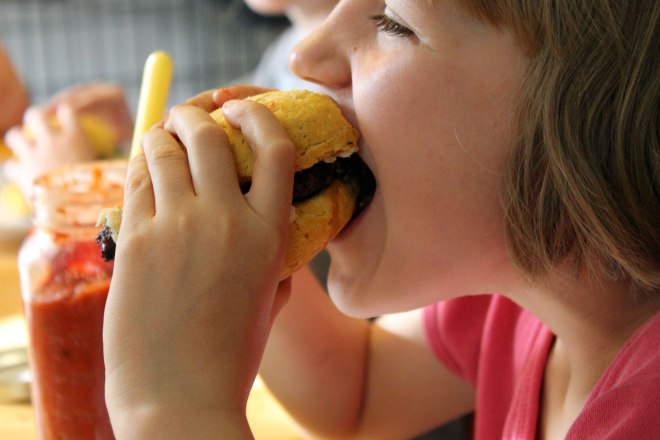My simple answer to the above question is this:
Yes it is!
You only have to look at the pictures of my children to see that they are thriving and full of energy!
There are a few caveats however… if your children are normal weight, healthy, active kids, they do not want to be on the very low-carb, weight-loss program that you might be following (over-weight and obese kids are a different matter – they need the low-carb diet in order to loose some of the excess weight (1), but they also need plenty of healthy fats to fuel their growing and developing brains).
Active, healthy kids need extra carbs to give them the energy they need and to prevent them from loosing too much weight. And they need plenty of healthy fats to help with brain development (at least 60% of the human brain is composed of fats, mostly the omega-3 variety, but saturated fats are also vital for brain development as they are important for forming the cell membranes of the nerve cells)
So don’t be afraid to give your kids sweet potatoes and other starchy veg. And don’t be afraid to give them the healthy fats (avocado, olive oil, olives, coconut oil, coconut, oily fish and even animal fats (100% grass-fed or pastured meat only) all count as healthy fats). Let them eat plenty of fruit as well… I always have a fruit-bowl on the kitchen counter that the girls know that they can snack from freely.
If they are lethargic, lacking in energy or actually loosing too much weigh, up the carbs in their diet and up the healthy fats as well, and that should solve the problem.
When you think about it, 50,000 years ago, stone-age mama and papa did not cook a hunk of meat for themselves and then pull out the wheaty-puffs for the stone-age kidlets… they fed the kids exactly what they ate. And those kids thrived – if they hadn’t, the human race would have died out way back then.
And even today, most cultures feed their kids on what they eat – spicy foods, fatty foods, veggies, you name it. If the adults can eat it and thrive, the kids can to. It is only in the West that we feel that we should be feeding our kids special “kid-friendly” food. And usually, this “kid-food” is pretty unhealthy stuff – high in insulin spiking carbs, lots of sugar, lots of salt, lots of food-colourings, artificial flavourings and sweeteners and laced with trans-fats – exactly the opposite of what growing bodies and brains need to eat.
So will giving up grains harm your child?
Not at all…
No one needs to eat grains.
And calorie for calorie, grains, even whole grains, are lower in nutrient density than fruit and vegetables. There are some useful graphs in this post that show the percentage of vitamins and minerals found in grains compared to vegetables, demonstrating that those veggies are the clear winner. And your child can obtain plenty of carbs from fruit and veggies…. and as a side-bonus, they will benefit from the larger amounts of nutrients. A Paleo diet almost consistently contains in excess of 100% of the RDA of all vitamins, with the exception of vitamin D, and the same is true of the vast majority of essential minerals as well. This post demonstrates this fact.. And whole grains are not necessarily the best source of dietary fiber either. Fruits and veggies contain at least as much fiber as whole grains do, so don’t worry that your child will lack for fiber or become constipated if they are not eating whole grains. As long as 50% of their plate is filled up with veggies they will be fine.
And when you consider the anti-nutrients in grains and pulses, you have even more reason to feed your children on a paleo diet. Most of our immune system is based on our gut flora and intestinal mucosa. The anti-nutrients in grains and pulses can damage the gut mucosa leading to leaky-gut syndrome, and it can alter the balance of the healthy gut flora (the friendly bacteria that live in our guts and help with immune function). For a child with an immature immune system, this can be bad news as it can lead to impaired immune development and even food sensitivities, intolerance and allergies later in life. (take my example – I developed a serious allergy to dairy in my mid 30’s and non-celiac gluten intolerance in my late 30’s early 40’s).
Gluten and lectins in grains and legumes damage the intestinal mucosa. This can prevent full absorption of the vitamins and minerals in your childs diet meaning that you child is not getting the full benefit of the food they are consuming.
And then there is the little matter of phytate. Also known as phytic acid, phytate is a form of phosphorus naturally found in plant materials. Grains and legumes (beans, peas etc) are naturally very high in phytate. The problem with this form of phosphorus is that it forms insoluble, and indigestible, complexes with many of the other vital minerals in the diet (most notably calcium, magnesium and zinc) which means that both the phosphorus, and the other minerals cannot be absorbed at all and pass unabsorbed through the gut and into the faeces…. (2, 3)
This can be a real problem for a whole-grain eater who is relying on their fortified breakfast cereal with milk to provide them with many of the minerals they need in their diet… phytate in that “heart-healthy wholegrain cereal” will bind the calcium in the milk and most of the minerals that the cereal is fortified with… total loss, and tbh a total waste of time eating it. You might as well feed your kids the cardboard box! (anyone remember that anecdotal scientific study that was done where they fed one group of lab rats a popular breakfast cereal, and a second group the box the cereal came in? Supposedly the group fed the cereal died, while the group fed the box thrived…. But I have never found a single paper to verify this… if anyone knows if one exists, I would be grateful if you could point me to it!)
Either way, there is plenty of evidence out there that eating phytates is not good for you (even the subject of my Doctorate showed this, albeit in laying hens, which is not really relevant here as I was looking at how it affected egg-shell quality – and to the best of my knowledge humans don’t lay eggs…)
Despite what people may tell you, giving up grains will not mean that your kids will be lacking in carbs… not only can children manage perfectly well on a ketogenic diet, they can thrive on it. They actually use this kind of diet to help control drug resistant epilepsy and other neurological disorders in kids. And those kids on a ketogenic diet remain perfectly healthy, with no weight gain or heart disease.
Besides, if you allow them free access to fruit, they will get more than enough carbs (fruit is very high in fructose). And you can always supplement with the more starchy veggies if you feel the need. I have yet to meet a kid who does not love sweet potatoes!
Giving up dairy is not a bad thing either (although some paleo parents feed their kids dairy as a part of a more primal way of eating if they tolerate the dairy well). This post by the Paleo Mom explains why dairy is not necessary to provide the calcium your kids will need to grow and thrive. And when you think about it, humans are the only species of animal that eats milk beyond infancy, and we are the only species that consumes the milk of another species as well. Contrary to what the milk marketing companies would like you to believe we don’t NEED milk in our diets! There has even been some evidence that consuming large amounts of dairy could have a negative effect on bone health (4, 5)
So why not give it a try?
Gradually replace the harmful foods in your child’s diet with Paleo and see how they do. If you are lucky enough to be a pregnant paleo-parent, you have it easy – you can just feed your child paleo from the get-go and avoid a lot of the problems us parents of existing kids who are used to eating a SAD (Standard American Diet) have!. But even the most resistant toddler will eat this way eventually – kids won’t let themselves starve, believe me… when they are really hungry they will eat. And there has been plenty of research to show that given a free choice of available foods, young children will naturally select a balanced diet (6)… so young kids can and WILL eat veggies, fruit, meat, healthy fats especially when they see their parents eating and actively enjoying them…
And my experience is that the older the kid, the easier it is… teens may be resistant at first, but they are also self-aware enough that they will realize that when they use their allowance to by a large mocha from the coffee-shop along with a huge donut, they feel like c**p the next day… And that Big Mac or Teen-Burger also makes them feel ill…. after a few sessions of this, they suddenly develop an aversion to those foods that make them feel ill…. And teens are old enough to read the books, look at the websites, understand the reason why eating a SAD is bad news.
Teens are also old enough to take a turn with the cooking, and I know no better way of getting kids interested in food than to encourage them to cook a meal of their own devising.
And no matter what age the kid is, they love the slightly mess aspect of cooking, especially when they get to be hands on with the food…
But even littlies can help out in the kitchen and cook simple foods:
Even if you have toddlers, you can get them to do really simple stuff like mixing up salad ingredients with their hands… and while they are doing it, encourage them to sample the individual veggies…. while it may not be perfect on the hygiene front, it is getting them to try stuff… besides it is your families bugs – you will be exposed to exactly the same bacteria when you kiss them good-night! Sadly I no longer have a kidlet of toddler age, so I can’t illustrate the last with a photo.
Despite this, I don’t advocate an all or nothing approach… if you totally ban non-paleo foods they become forbidden fruit… the minute your child has access to them (at a birthday party, at a school event, snack-time at school/playgroup etc) they become all the more desirable. OK, don’t allow them in the house, but don’t outright ban them unless there is a food allergy or intolerance to that particular food ingredient. Let your child sample the non-paleo foods at social events (birthday parties etc), then talk to them about how they made them feel (even a toddler can understand that that food was not as tasty as mummy’s home-cooked food!). If they feel ill, they will gradually realize that eating them is not worth the suffering!
One other solution is to make them paleo versions of the food that they are used to. You can “bread” chicken or fish with coconut or nuts to make a paleo version of chicken nuggets and fish sticks. Make cauliflower “rice” and zoodles or spaghetti squash in place of pasta. Make paleo treats on occasion to replace the pancakes, the cookies and the muffins. You can make paleo bread for pizzas or burger buns as well.
By having a few easy go-to recipes that you can pull out when you need a paleo substitute for your kids favourites you can make that transition so much easier.
And seriously, when your kids are young, it is YOU that controls the food that they eat. If your child is overweight or suffering from a food related illness, it is down to you. You are the one buying the food they eat. If you don’t buy it, they can’t eat it.
Things do get a little more complicated once they reach the teenage years, true (Yes your teen will slink down to 7-11 occasionally to buy a Big-gulp, but hey, once in a while is not going to kill them! – C went to a friends house the other day and spent her allowance on a cheesecake!), but if you educate your children on healthy eating habits (and a HUGE part of this education is them seeing their parents eating and enjoying healthy foods – family mealtimes RULE for this!), then they will know how to make healthy eating choices for themselves in the future.
Surely that is one of the best gifts you can give your children!







